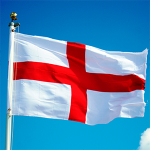
Spring is well and truly here which amongst other things, means it's almost time to celebrate that most English of days, St. George's Day!
St. George's Day was at one time a national holiday in England. It is now more of an event that is celebrated in some areas with parades, dancing and similar activities. Yet it’s popularity and prominence is increasingly with every passing year...
Visit a local Church on Sunday, April 23rd and you’re very likely to hear the strains of William Blake's classic hymn 'Jerusalem'. Flags with the image of St. George's cross are flown on specially-patriotic houses, not forgetting good old bunting at your local pub or Hall….Many others display their pride with nifty car flags or take great pleasure in adorning their work desk with a natty table equivalent. Whatever the method, the English are making their pride known.
So then why is April 23rd not a public holiday? Schools, stores, post offices, businesses and other organisations are open as usual. Public transport services run to their usual timetables. In recent times, there has been a push, involving campaigns and petitions, to make the day a public holiday in England. A recent Government Poll shows that 73% of people in England want April 23rd to be a nationally-recognised Bank Holiday. The Guardian writes that political parties ignore the rise of English identity 'at their peril' ...Many say that the Irish have long celebrated St. Patrick's Day without having to take a sickie off work! (Admittedly they probably do the day after, though)
So what’s the problem?
Well as always, look no further than money, probably. According to a report from April 2012 by the Centre for Economic and Business Research, each Bank Holiday can cost the economy about £2.3 billion in lost work. That always dents the chances somewhat…Also St. George's Day was once celebrated as widely as Christmas but the celebrations waned by the end of the 18th century after England had united with Scotland on May 1, 1707.
Other reasons may include the fact that in true politically correct style, England has, some say, become too multicultural for such a specific patriotic celebration of Englishness. The argument is that it would alienate many other diverse cultural groups. A little contentious, to say the least. Particularly as good old St, George was not even English himself and is actually the patron saint of a number of other places, such as Bulgaria, Ethiopia, Georgia, Greece, Portugal and Russia!
St. George was born sometime around the Year 280 in what is now Turkey. He was a soldier and rose up through the ranks of the Roman army, eventually rising up to the level of a personal guard to Emperor Diocletian. He was executed for being a Christian on April 23rd 303, and is buried in the town of Lod in Israel.
St. George is most widely known for supposedly slaying a dragon. Legend says that the only well in the town of Silene was guarded by a dragon so in order to get water, the townspeople had to offer a human sacrifice every day to the great dragon. The person to be sacrificed was chosen by lots. (Very democratic, it has to be said) At the time our St. George was visiting, a Princess had been selected as the sacrificial lamb that day. However, he killed the dragon, saved the Princess (as you do) and gave the people of Silene unfettered access to the water. In gratitude, they all converted to Christianity. It is thought that the dragon represents a certain type of pagan belief that included the sacrifice of human beings.
The most widely recognised symbol of St. George's Day is St. George's Cross. This is a red cross on a white background, which is often displayed as a flag. It is used as England's national flag, forming part of the Union Flag, the national flag of the United Kingdom of Great Britain and Northern Ireland. Saint George's cross was originally the flag of the maritime Republic of Genoa. Around 1190, the King of England started paying the Doge of Genoa to protect ships originally from the city of London and the rest of England that sailed in the Mediterranean.
During the crusades, English knights used the St. George's cross as a part of their uniform. It has been the official flag of England for centuries now, but the Union Jack Flag, a combination of St. George's cross, St. Andrew's cross and St.Patrick's cross, is the overall national flag of the United Kingdom. Currently, the St. George's cross is used as a national symbol by fans of the English national football, rugby and cricket sides. At all international matches flags and scarves bearing this cross are worn and people will often adorn their faces with a painted version also!. It also has a prominent place on the arms of the City of London and the flags of the city of Barcelona, Spain, and the country of Georgia.
5 Extremely English Things to Do this St. George’s Day
We’ve come up with a list of five quintessentially English things you can do this St. George's Day to commemorate it properly.
- Show your pride!
Whether from your car, window or desk, don’t be shy about parading your patriotic spirit with a classic St. George’s flag of some description!
- Dress the Part
It’s become a tradition to dress in the red & white colours of the English flag when celebrating St. George's Day. If you don’t want to be entirely dressed in two tones, maybe grab the St. George cross flag instead…
- Wolf down a Feast
Be sure to eat some traditional English staples like a full English breakfast, Bangers’n’Mash or a traditional Full Roast, all in tribute to the Meat Slayer himself.
- Visit a Pub
What could be more English than a trip to your local boozer? Grab a seat and a pint & engage in some patriotic merriment to mark the occasion…
- Visit the Theatre
The 23rd of April is also thought to have been the birthday of William Shakespeare! Why not celebrate this other iconic English figure with a trip to your local theatre?
Make sure that you do at least one of our extremely English things to do on the 23rd April to make sure you feel like you’re part of the festivities.















